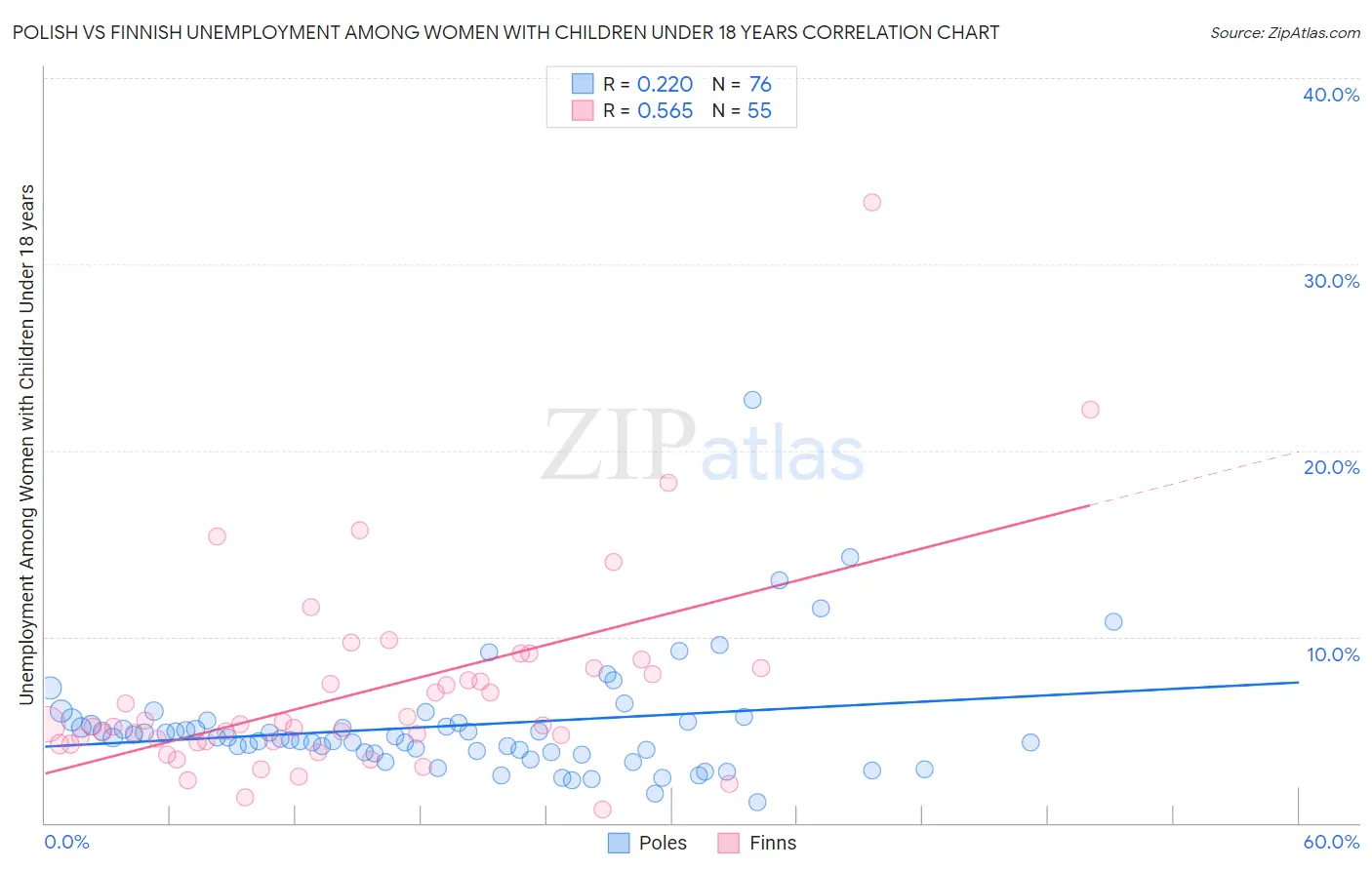Polish vs Finnish Unemployment Among Women with Children Under 18 years
COMPARE
Polish
Finnish
Unemployment Among Women with Children Under 18 years
Unemployment Among Women with Children Under 18 years Comparison
Poles
Finns
5.0%
UNEMPLOYMENT AMONG WOMEN WITH CHILDREN UNDER 18 YEARS
99.2/ 100
METRIC RATING
37th/ 347
METRIC RANK
4.9%
UNEMPLOYMENT AMONG WOMEN WITH CHILDREN UNDER 18 YEARS
99.4/ 100
METRIC RATING
29th/ 347
METRIC RANK
Polish vs Finnish Unemployment Among Women with Children Under 18 years Correlation Chart
The statistical analysis conducted on geographies consisting of 508,328,187 people shows a weak positive correlation between the proportion of Poles and unemployment rate among women with children under the age of 18 in the United States with a correlation coefficient (R) of 0.220 and weighted average of 5.0%. Similarly, the statistical analysis conducted on geographies consisting of 381,959,470 people shows a substantial positive correlation between the proportion of Finns and unemployment rate among women with children under the age of 18 in the United States with a correlation coefficient (R) of 0.565 and weighted average of 4.9%, a difference of 0.75%.

Unemployment Among Women with Children Under 18 years Correlation Summary
| Measurement | Polish | Finnish |
| Minimum | 1.1% | 0.70% |
| Maximum | 22.7% | 33.3% |
| Range | 21.6% | 32.6% |
| Mean | 5.2% | 7.1% |
| Median | 4.6% | 5.2% |
| Interquartile 25% (IQ1) | 3.8% | 4.3% |
| Interquartile 75% (IQ3) | 5.4% | 8.3% |
| Interquartile Range (IQR) | 1.6% | 4.0% |
| Standard Deviation (Sample) | 3.1% | 5.5% |
| Standard Deviation (Population) | 3.1% | 5.4% |
Demographics Similar to Poles and Finns by Unemployment Among Women with Children Under 18 years
In terms of unemployment among women with children under 18 years, the demographic groups most similar to Poles are Mongolian (5.0%, a difference of 0.020%), Bhutanese (5.0%, a difference of 0.030%), Luxembourger (5.0%, a difference of 0.080%), English (5.0%, a difference of 0.13%), and Immigrants from South Central Asia (5.0%, a difference of 0.14%). Similarly, the demographic groups most similar to Finns are Immigrants from Eastern Asia (4.9%, a difference of 0.050%), Burmese (4.9%, a difference of 0.070%), Soviet Union (4.9%, a difference of 0.21%), Swiss (4.9%, a difference of 0.28%), and Cypriot (5.0%, a difference of 0.29%).
| Demographics | Rating | Rank | Unemployment Among Women with Children Under 18 years |
| Immigrants | China | 99.6 /100 | #23 | Exceptional 4.9% |
| Belgians | 99.5 /100 | #24 | Exceptional 4.9% |
| Chinese | 99.5 /100 | #25 | Exceptional 4.9% |
| Swiss | 99.5 /100 | #26 | Exceptional 4.9% |
| Soviet Union | 99.5 /100 | #27 | Exceptional 4.9% |
| Immigrants | Eastern Asia | 99.5 /100 | #28 | Exceptional 4.9% |
| Finns | 99.4 /100 | #29 | Exceptional 4.9% |
| Burmese | 99.4 /100 | #30 | Exceptional 4.9% |
| Cypriots | 99.3 /100 | #31 | Exceptional 5.0% |
| Dutch | 99.3 /100 | #32 | Exceptional 5.0% |
| Croatians | 99.3 /100 | #33 | Exceptional 5.0% |
| Immigrants | South Central Asia | 99.2 /100 | #34 | Exceptional 5.0% |
| Luxembourgers | 99.2 /100 | #35 | Exceptional 5.0% |
| Mongolians | 99.2 /100 | #36 | Exceptional 5.0% |
| Poles | 99.2 /100 | #37 | Exceptional 5.0% |
| Bhutanese | 99.2 /100 | #38 | Exceptional 5.0% |
| English | 99.1 /100 | #39 | Exceptional 5.0% |
| Greeks | 99.0 /100 | #40 | Exceptional 5.0% |
| Immigrants | Bosnia and Herzegovina | 99.0 /100 | #41 | Exceptional 5.0% |
| Eastern Europeans | 98.9 /100 | #42 | Exceptional 5.0% |
| Turks | 98.9 /100 | #43 | Exceptional 5.0% |